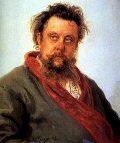
Modest Mussorgsky
Russia at the latter half of the nineteenth century was in a crisis socially, politically and artistically. On one hand, Russia ached to be western, modern and accepted. On the other, she had a rich and proud nationalist heritage.
In the Russian music world, the two ends of the spectrum of this cultural clash were held by Tchaikovsky for the liberals and Modest Mussorgsky for the traditionalists.
Mussorgsky was not a professional musician. He joined the army aged 17 and later the civil service. His lifelong battle with alcoholism prevented him from progressing through the ranks to a level where he could devote more time to music.
Yet he managed to get a few composition lessons from Balakirev and Cui and collaborated with Rimsky-Korsakov. He was certainly a talented pianist; he gave a concert of a John Field concerto at age nine. But his music remained unrefined and raw compared to his contemporaries. After his death, Rimsky-Korsakov saw fit to “clean up” Mussorgsky's music, even rewriting entire sections before publication.
He was fervently nationalist and along with Balakirev, Cui, Rimsky-Korsakov and Borodin who shared his views on the future on Russian music, they became known as the “
Mighty Handful”.
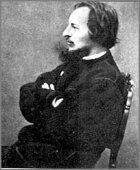
Victor Hartmann
Mussorgsky's closest friend was Victor Hartmann. Hartmann was a painter, architect and designer who shared their views on Russian art. His paintings went back to traditional Russian legends and folktales. As an architect, he rejected the neo-classical Roman styles that were becoming fashionable, and designed buildings based on medieval and traditional styles.
In short, what Victor Hartmann was to Russian art and architecture, Mussorgsky and the “Mighty Handful” were to Russian music.
In 1873 Hartmann died suddenly at the age of 39. Mussorgsky was devastated. Vladimir Stassov, an art critic and mutual friend, organised a posthumous exhibition of Hartmann's paintings, sketches and designs, over 400 in total. Mussorgsky returned from the exhibition inspired, and immediately began work on his best known work “
Pictures at an Exhibition”.
Pictures at an Exhibition is a musical representation of wandering through an art gallery. Few of Hartmann's original paintings survive, but the few that do (shown below) set the scene fro Mussorgsky's music.
The work begins with
Promenade, a theme that returns four times throught the music and serves to unify the whole work.
Promenade in a curious 5/4 time, bridging the ten larger sections, represents the viewer, moving between paintings, stopping at some exhibits, moving onto others.
Gnomus - The Gnome
Based on Hartmann's design for a nutcracker,
Gnomus describes a grotesque little imp, dancing in and out of shadows.
Il Vecchio Castello - The Old Castle
Another
Promenade leads us to the second painting. While travelling through Italy, Hartmann painted a watercolour of a medieval tower, with a minstrel playing a lute. The music here is introspective with an old-world beauty. Again the original painting has been lost.
Tuileries: Dispute d'enfants après jeux - Children Quarreling at Play
This time, the
Promenade takes us to Mussorgsky's representation of children playing in the Tuileries Gardens in Paris. Original artwork lost.
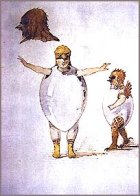 Bydlo - Ox Cart
Bydlo - Ox Cart
The heavy leaden walk of the cattle is heard pulling the cart slowly through the mud. Again, Hartmann's sketch is lost.
Ballet of the Unhatched Chicks
Hartmanns sketch is for the costume design for an opera called
Trilbi by Julius Gerber. The music describes a frenetic, chaotic dance of children dressed as unhatched chicks. Hartmann's original design is at right.
Samuel Goldenberg & Schmuyle
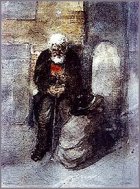 Samuel Goldenburg and Schmuyle
Samuel Goldenburg and Schmuyle were originally the subjects of two separate paintings by Hartman of two Jews from Sandomir in Poland. Samuel Goldberg is richly dressed, and Schmuyle is in rags (only this painting survives, at right). Mussorgsky combines the two paintings into one piece of music where he depicts a conversation between the two. The rich Jew is represented by a heavy pompous theme, the poor man by a high-pitched bleating theme. As time goes on, the rich man's voice drowns out the other's, as the themes merge.
Limoges marche - The Market at Limoges
Another
Promenade takes us to a marketplace at Limoges, the music depicting the hustle and bustle of women and haggling vendors.
 Catacombae Sepulcrum romanum - Roman Burial Catacombs
Catacombae Sepulcrum romanum - Roman Burial Catacombs
This eerie picture is a self-portrait of Hartmann touring the ancient Roman burial catacombs under Paris, based on Victor Hugo's description in
Les Miserable. The source of the glow was candles and oil within the skulls.
Con mortuis in lingua mortua - With the Dead in the Language of Death
The catacombs leads to a section not directly inspired by a Hartmann painting. It is Mussorgsky's reflections on the death of his friend.
 The Hut On Fowl's Legs (Baba-Yaga)
The Hut On Fowl's Legs (Baba-Yaga)
Hartmann's design was for an ornate clock inspired by the ancient folktale of the Baba Yaga, the witch who lives in a house on chicken legs.
Mussorgsky's music depicts the witch flying through the air in her mortar in which she grinds human bones. She flies into a forest, her hut following her on the ground. The music is subdued and menacing. Then all of a sudden she re-appears, hurtling through the sky, straight into the final piece of music.
The Great Gate of Kiev
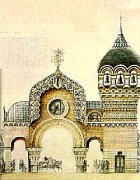
The Great Gate of Kiev was a project that never saw the light of day. It was Hartmann's entry for a competition to design a commemorative building to celebrate Tsar Alexander II's
miraculous escape from an assasination attempt.
It is the
Promenade theme again but this time in a purposeful 4/4 time. It describes the grandness of the gate, with its Slavonic helmet-inspired arch and a grand bell tower by its side, from which sounds a victorious tolling of bells.
Mussorgsky's original piano version of
Pictures was not even published until 5 years after his death, and remained almost unknown until Ravel's masterful orchestration of it in 1922. From then on it has become an orchestral favourite.
So much so that the original piano version is rarely heard. Yet this really shows the true Mussorgsky, still richly layered music, but filled with raw energy. The piano and pianist must be capable of alternating between sweet singing, biting humour and pounding threat.
Evgeny Kissin is one of the world's great pianists, mature beyond his years (he was born in 1971). His concerts are sell-outs the world over, his stage presence electrifying, and his choice of program both intelligent and challenging. He brings to the
Pictures exactly the vigour that is required. This recording easily betters the classic Horowitz recording of the 1960's in my book.
And includes some well-known Bach works (for keyboard and organ) and a surprise by Glinka.
If his recording of
Pictures at an Exhibition is anything to go on, this young man has far to go.
Please support Good-Music-Guide.com
by purchasing this CD using this link.

Track Listing
Modest Mussorgsky
Pictures at an Exhibition
Evgeny Kissin
J.S.Bach
- Toccata, Adagio & Fugue in C: Prelude
- Toccata, Adagio & Fugue in C: Intermezzo: Adagio
- Toccata, Adagio & Fugue in C: Fugue
Glinka
- The Lark
Mussorgsky: Pictures At An Exhibition
- Promenade
- Gnomus
- Promenade
- Il vecchio castello
- Promenade
- Tuileries
- Bydlo
- Promenade
- Ballet of the Unhatched Chicks
- Samuel Goldenberg & Schmuyle
- Promenade
- Limoges marche
- Catacombae (Sepulcrum romanum)
- Con mortuis in lingua mortua
- The Hut On Fowl's Legs (Baba-Yaga)
- The Great Gate of Kiev